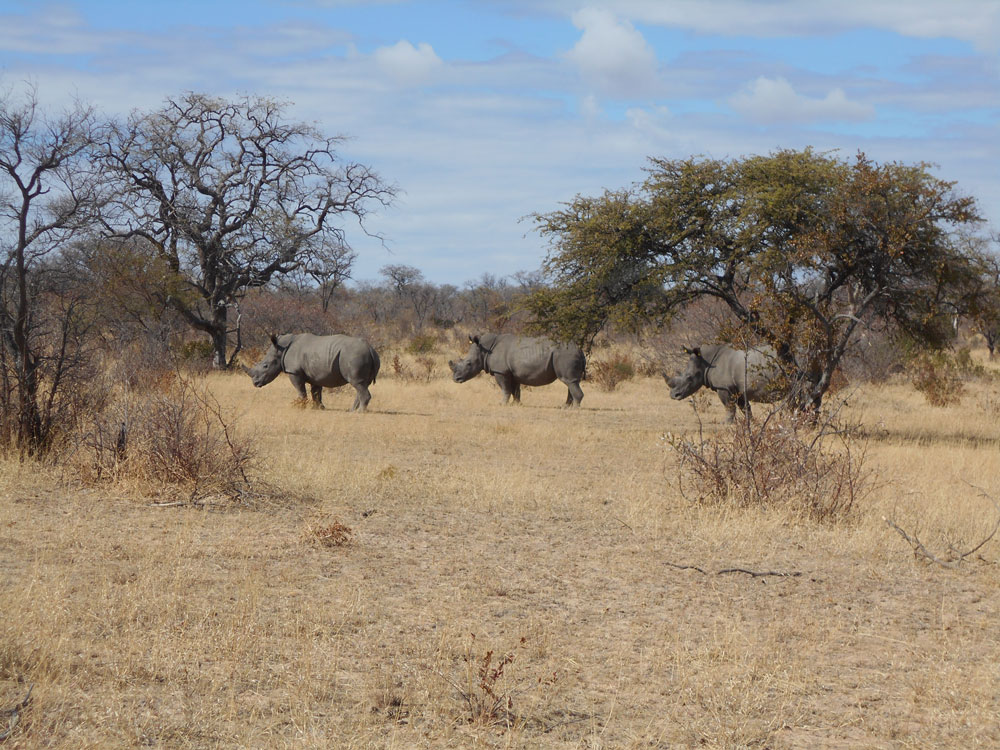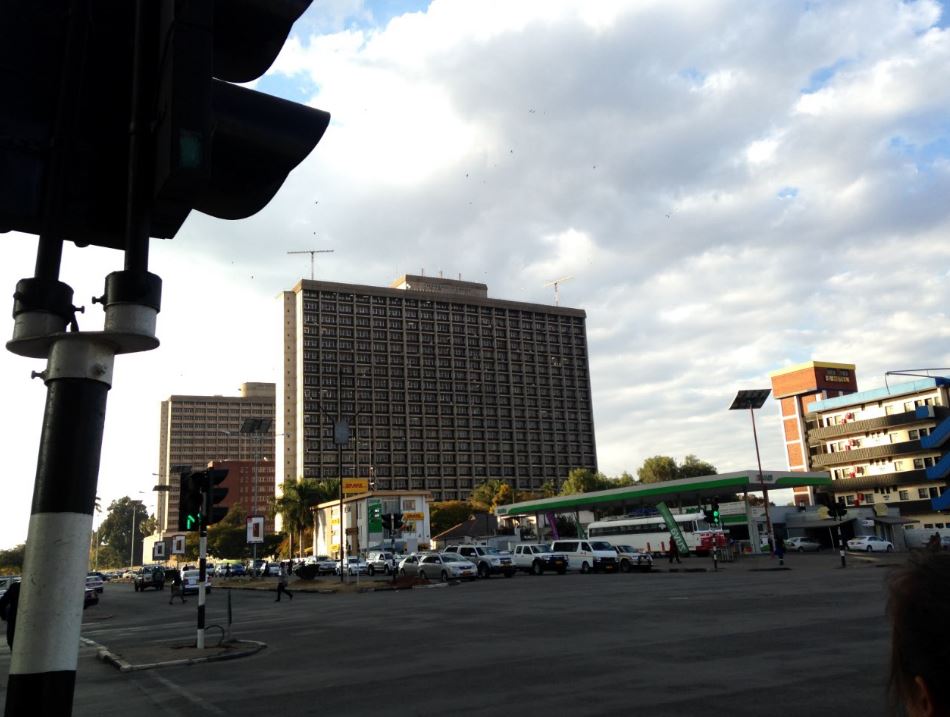The Rhino Man
There were eighteen of them. Mostly young, almost entirely Australian and all a few days into their trip. The group were on an overland tour. Overland tour operators take care of literally everything for their customers. The group get driven around in a gigantic bus, sitting higher than anyone else on the road; they get taken to their campsites where they are provided with tents; they get ferried to specific tourist attractions; and they get cooked for each and every day. This group had started in South Africa and were now staying for a couple of nights at Burke’s Paradise, the campsite and lodge that Claire and I were also using. Their matching green safari tents all in a neat line opposite our little blue tent that was, by this point in the trip, looking pretty worse for ware and sagging in places.
Their large bus had pulled in whilst Claire and I were out spending the day walking with rhinos and seeing ancient cave paintings. We got back from our day out and they were all sat in the living room at the campsite chatting away. We arrived to a chorus of questions. Most of them were young and were intrigued as to how we were finding our travels, seeing as we were having to get local buses around and having to organise most things for ourselves. They were a really friendly bunch and were waiting to speak to one of the guides from the Rhino trekking tour company, as that was their organised day out the following day. It turns out that the man they were waiting to hear from (he was going to show up and let them know what they’d be doing the next day) was someone Claire and I had heard mentioned that previous day.
This chap, let’s call him The Rhino Man, is one of a number of guides who take people out to see the rhinos in all their glory. In fact, whilst we were out looking at rhinos in the park, The Rhino Man had also taken a group out. We avoided bumping into his group through some careful manoeuvring on behalf of our own guide – I guess it ruins the experience a little if you bump into another group of tourists also looking to spot the rhinos. It was as we were making our way in the opposite direction of The Rhino Man that we were told about him. Apparently he talks a lot. When you are on a guided tour, it’s fascinating to listen to the knowledgeable guide explain all about the animals, history or scenery you’re being presented with, so a talkative guide is a good thing. However, apparently The Rhino Man has a reputation for going on a little too long. We were told that tourists tend to drift off as he goes on about the rhinos and he spends so long with them that often the groups end up missing out on some of the latter parts of the day – the cave tours, seeing Cecil Rhodes’ grave and anything else that they may have had planned. So, when The Rhino Man turned up to speak to the overland group Claire and I were intrigued to see what he was like. The group of eighteen took their seats and Claire and I ducked out into the kitchen to get out of the way. We thought we’d stand there for five minutes whilst he gave them a run through of the next day’s activities, before joining the group again once he left. We ended up standing in the kitchen for about an hour.
He addressed them like a teacher addresses a class of schoolchildren and ran through the day’s activities thoroughly, interspersing his speech with little snippets of interesting information – the cost per gram of rhino horn, how heavy the rhinos are etc. However, when he asked the group if they had any questions and they responded with a couple, he really got into his stride. Stood there, in the doorway, mid thirties, white and in khaki shorts and a khaki top and a khaki hat, with khaki socks most probably and some large black boots, he took them (and by proxy us) on one hell of a ride. On the topic of poachers killing rhinos in order to steal their horns one girl asked the following question: “Didn’t they just burn a lot of ivory somewhere?” This question is in relation to the news story that in South Africa the government burned a few million pounds worth of elephant tusks that they’d confiscated off poachers. Or so we thought!
“What is an elephant tusk?” asked The Rhino Man, his face cross. He looked around at the confused group of tourists. “What is an elephant tusk made of? Think about it.” He asked again.
“Bone?” asked one girl.
“No not bone. Don’t be so silly,” he said. “Come on, what is an elephant tusk?”
“Horn?” asked another girl.
“No, not horn. It’s not horn. Rhinos have horns. Come on, what is an elephant tusk?” he asked again. His tone was that of a teacher asking their class to give an answer to a question that they’d just covered. The group all sat there in silence. “What is an elephant tusk?” he asked again. Claire and I were in the kitchen hidden from view. “What do you think an elephant tusk is made out of?” he asked yet again.
“Hair?” asked one of the group.
“No no no, it’s not hair. It’s a tooth. An elephant tusk is a tooth.” But he wasn’t done there. He had another question: “Now, what do they use to identify dead bodies?” Again the group looked confused. They were enjoying socialising with a beer and were now taking part in an impromptu lesson. “What do they use to identify dead bodies?” he asked again.
One girl took a guess: “Fingerprints?”
“No they don’t use finger prints,” he said. “In a plane crash, what do they use?”
“Your passport?” asked another.
“No not your passport. It will burn. What do they use?” silence fell over the room. In the kitchen Claire and I had guessed the answer to be teeth. He asked again: “What. Do. They use. To identify bodies in plane crashes?”
One guy timidly said: “Teeth?”
“Yes!” blurted The Rhino Man, slightly frustrated. “Teeth. Teeth don’t burn. That’s why they use teeth to identify bodies. So, if teeth don’t burn and elephant tusks are teeth, then how can they burn a big pile of teeth? Doesn’t work does it? Doesn’t bloody work. No. No what they did, is they burnt a big pile of papier mache tusks and sold the ivory on the black market!” We closed our eyes. So that’s where he was going. After all this time it was a simple conspiracy theory. I do, I must admit, love a good conspiracy theory. Whether it’s whackos who believe that the moon landing faked, or angry people who believe that over 95% of scientists and loony left politicians have joined together to invent climate change for some reason, or those individuals who believe that Elvis is still among us, they are always entertaining. And here was a new one. According to The Rhino Man, the South African government had burnt fake ivory to send a message, whilst at the same time making a sweet profit illegally by selling the ivory, that they weren’t burning, on the black market. The group said nothing. To us, hiding in the kitchen, it felt like a metaphorical collective shrug of the shoulders.
One girl then asked how he felt that the issue of rhino horn poaching should be solved. His answer, legalizing the rhino horn trade. Let the game parks cut off the horns of the rhinos (which they are already doing to protect them from poaching) and then sell the horns themselves to make a profit, which can go into looking after the rhinos. This sounded like an interesting idea. He elaborated more on the subject, explaining how the rhinos don’t need the horns, as they are essentially fingernails (a point that may or may not hold weight), and explained how legalising the trade would eradicate the needless slaughter of rhinos, and it did sound like a good idea.
During the talk, as more and more questions came his way, you could tell that The Rhino Man was thoroughly enjoying himself. Here he was, The Rhino Man, imparting wisdom and knowledge to the un-rhino-educated. One girl asked him how the poachers got into the park. His reply, a nonchalant: “How aren’t they getting in?” Now, that’s not an answer. To me, that doesn’t sound like an answer. The girl wanted to know how they were getting in. And all he did was ask her another question
Minutes later he said: “I lost one of my daughters in the park the other week.” Claire and I had been quietly giggling along during his lecture, and here we froze. One of his daughters had been killed in the park. The group fell silent. There was a tension in the air. “She was shot by a poacher.” He added. “This rhino and I were so close. I was like a father. And then I found her dead” Everyone breathed a sigh of relief. The Rhino Man went on to explain that this one rhino was born in his presence. And he’d now become close with the rhino. All of the other rangers weren’t as close to any rhino in the park as he was to this one. None of the other rangers were able to get as close to the rhinos as The Rhino Man was with this one. And mere weeks ago, this rhino had given birth. “And I went up to her with her new baby, and the other rangers were like ‘wow don’t get too close’ but I knew that she’d let me close. And I was such a proud grandfather that day.” Some of the girls said ‘awwww’. Claire and I rolled our eyes. To be fair on The Rhino Man, finding one of the rhinos in the park dead, especially one which he had a special bond with, must have been hard. But it was his choice of words and penchant for the dramatic that tickled us.








Comments are closed here.